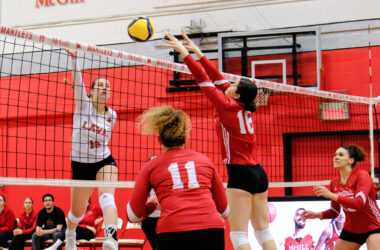Drive to Survive, Netflix’s heavily dramatized Formula 1 series, brought millions of viewers to the sport and reversed its slow, decade-long decline in popularity. With the release of its sister show, Full Swing, on Feb. 15, fans are wondering if the media conglomerate can work its viewership magic once again—this time, with the world of golf. While on the surface, Full Swing is set to have the same success in transforming the sport’s viewership, the show’s first season falls short of the green.
Based on Drive To Survive‘s model, Full Swing, a Vox Media Studios and Box to Box films production, takes a sport struggling in the public eye and puts the most famous golfers from the Professional Golfers’ Association of American (PGA) tour and LIV Golf on the global stage. The show opens with 15-time PGA tour winner Justin Thomas and closes with PGA golden boy Rory McIlroy. But the show’s absence of women and glossing over of LIV Golf hinders the possibility of increased viewership by failing to delve into the most interesting aspects of golf’s current affairs.
Not unlike Formula 1, golf is commonly seen as a sport for old, wealthy, white men because of its history of exclusion—the PGA in particular. The growing popularity of the Ladies Professional Golf Association (LPGA) was a golden opportunity for Netflix to draw new viewers in, but the company utterly failed to do so. Just as they did with Drive to Survive, where women speaking accounted for an abysmal 1.54 per cent of season five’s entire runtime, Netflix failed to spotlight women in Full Swing.
Despite the rapidly increasing viewership of the LPGA, up 32 per cent from 2021 and 69 per cent from 2020, the show features zero women athletes. The vast talent of the LPGA deserves to be placed at the forefront. In 2022, Minjee Lee beat every PGA pro at every distance in accuracy from the fairway. Lydia Ko has 101 top 10 finishes at only 25 and had 10 LPGA tour wins at the age of 18––five years earlier than Tiger Woods earned his first 10 PGA wins. Nelly Korda, largely regarded as the face of American women’s golf, won five events, became a major champion, and took home an Olympic gold all in the same year.
Even the PGA is coming to recognize how important the LPGA is to the game with the announcement of the Grant Thornton Invitational in Naples. The talent is there, the excitement is there, the desire to watch is there––but Full Swing had other priorities.
In an attempt to replicate the reality TV drama witnessed in Drive to Survive, the show created a villain: LIV Golf. The Saudi Arabian-funded golf tour promises an all-men’s championship, a guaranteed paycheck, and an extra $4 million to the winner—unlike the PGA tour where players are paid according to placement.
Athletes who sign with LIV Golf are accused by their opponents in the show of only caring about money and overlooking Saudi Arabia’s human rights abuses. The Netflix show adopts this criticism, playing Big Bag of Money by G-Eyez in the background when introducing Ian Poulter and Dustin Johnson, two LIV Golf athletes. But while failing to provide any substantive criticism of LIV, Full Swing simultaneously functions as a PGA apologist, ignoring the Tour’s pitfalls and functioning as an eight-episode PGA advertisement.
Since Full Swing came out just under a month ago, it is unclear what the long-term impact will be on golf viewership. The low ratings for LIV Golf’s debut event prompt some to believe the threat to the PGA is fading and along with it, the potential for dramatization. But one thing is certain: Netflix must do better with season two. Women and the LPGA are vital to increasing viewership, especially in light of the introduction of LIV––a league that wants nothing to do with women athletes. With plenty of time and resources, Full Swing must course-correct if it wants to hold onto viewers and grow the game of golf.









